The Everglades National Park is North America’s largest subtropical geographical region. Its location is at the meeting point of fresh and brackish water, shallow bays, deeper coastal waters, and temperate and sub-tropical America. Therefore, it forms a complex habitat supporting various plants and animals. Everglades is an international Biosphere Reserve, a World Heritage Site, and a specifically protected region under the Cartagena Treaty. Everglades is home to North America’s most important wading bird breeding site, the longest continuous sawgrass prairie stand, and the largest mangrove habitat in the Western Hemisphere.
Location
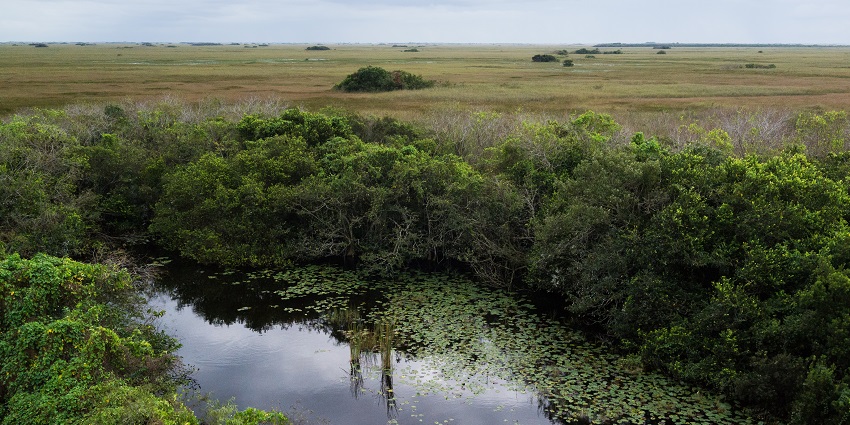
Photo: Russ / Wikimedia Commons
Everglades Park has three entrances in three distinct cities, which is unusual for national parks. The combined land area of Miami Dade County, Monroe County, and Collier County makes up 1,509,000 acres of Everglades. Please be aware that there is no connection between these entrances. Due to the large distances and lack of public transportation within the park, a car is required when visiting the Everglades. At least an hour’s drive separates the Flamingo Visitor Center from each of the three entrances.
How To Reach

Photo: Sharon Hahn Darlin / Wikimedia Commons
By Air: Miami International Airport (MIA), roughly 45 miles northeast of Everglades, is the nearest airport to the park. You can take a shuttle service or rent a car from either airport to get to the park.
By Train: Tri-Rail-Metrorail Transfer Station is not directly connected to Everglades. To go to this park you can take the 2400 train to Dadeland South Stat. Rail Southbound, walk to the Dadeland South Metrorail Station, take the line 38 bus to Busway & Sw 328 St.
By Road: From Miami to Everglades City, Highway 41 follows the Everglades’ northern border. If someone wants to go to Shark Valley, where there are a ton of alligators, they choose this route. The Tamiami Trail is a picturesque byway that runs along Highway 41.
Places To Visit In And Around Everglades National Park
Visitors can explore several fascinating places near the Everglades National Park. Here are five notable attractions:
1. Anhinga Trail
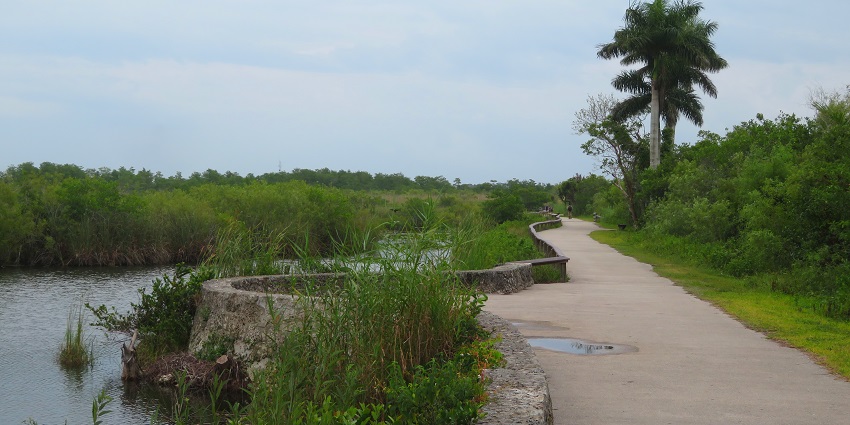
Photo: Ken Lund / Wikimedia Commons
The well-known Anhinga Trail is a self-guiding boardwalk and paved path that winds through and over freshwater slough and sawgrass marsh. It is 4.2 km away from Everglades. Views of the prairie and the slough’s crystal-clear waters can be seen from the paved route that runs beside the water and ends at a winding boardwalk. During winter’s dry season, lower water levels concentrate aquatic creatures in the slough, including alligators, fish, turtles, anhingas, and birds. Due to its abundance of wildlife, this is one of the park’s most visited paths.
Location: Royal Palm Visitor Center, Everglades Park, FL
Timings: 10 AM – 4 PM
Entry Fee: $78
2. Shark Valley

Photo: Daderot / Wikimedia Commons
Shark Valley is situated in the centre of the Everglades freshwater marsh, 30 miles west of Miami, off the Tamiami Trail (U.S. Highway 41). Along a 15-mile circle route, you can enter Shark River Slough by foot, bicycle, or a narrated tram ride. You will be able to see wildlife up close along the circle route. A 70-foot observation tower located halfway around the loop offers a broad view of the sawgrass marsh as it would have looked to the locals more than 300 years ago. The Ernest F. Coe Visitor Center is 50 kilometres from Shark Valley.
Location: 36000 SW 8th Street. Miami, FL
Timings: 8:30 AM – 5 PM
3. Ernest F. Coe Visitor Center

Photo: Everglades NPS / Wikimedia Commons
Ernest F. Coe Visitor Center is situated at Everglades Homestead gate. Over 360 distinct bird species, at least 50 types of reptiles, manatees, and the Florida panther can all be found on the park’s 1.5 million acres. The centre has informative videos, artwork by local artists, and educational displays. Staff members at the visitor centre are hospitable and are always pleased to assist you with planning your trip to the park and to give you information about camping and hiking routes. Long Pine Key Nature Trail, one of five bike paths in Everglades National Park, is accessible from the visitor centre.
Location: 201 S Biscayne Blvd, Suite 2200
Miami, FL 33131 USA
Timings: 9 AM – 5 PM
Entry Fee: $460
4. Royal Palm Visitor Center
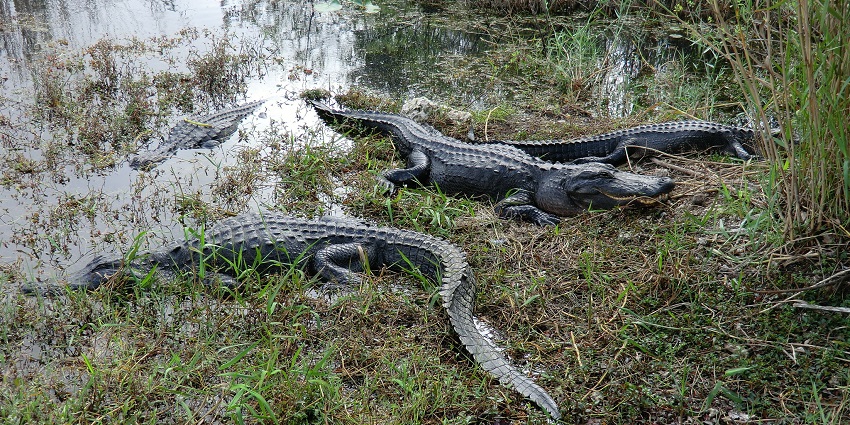
Photo: Reinhard Link / Wikimedia Commons
Built in the year 1916, Royal Palm State Park is considered the heart of the Everglades. Visitors can walk the elevated boardwalks of the Anhinga and Gumbo Limbo Trails, park in the lot, and pick up a guide pamphlet at the visitor centre. Furthermore, they must keep an eye out for a variety of wildlife, such as alligators, great blue herons, and the trail’s namesake, the anhinga, a water bird with a long, snake-like neck.
Location: 4 miles West of Ernest F. Coe Visitor Center on Route 9336
Timings: 8 AM – 4:15 PM
Where To Stay

Photo: Anonymous / Pixabay / Image For Representation Only
The park areas between Everglades City and Homestead are about an hour and a half apart. For those who wish to fully experience the park, we suggest staying in both locations. Homesteads are better for things like Robert’s fruit stand, the Flamingo (a must-see), the Anhinga Trail, etc. It’s also an excellent place to stop for water activities in Key Lagoon or Biscayne National Park, both of which are close by. Big Cypress National Preserve, which is near Everglades City, is fantastic, more swampy than marshy.
Where To Eat

Photo: laye cana / Pexels / Image For Representation Only
There are several dining options such as the Flamingo Lodge, and the Flamingo Restaurant, which serves breakfast, lunch, and supper every day. The Ernest F. Coe Visitor Center bookshop, the Royal Palm Visitor Center bookstore, the Flamingo Marina store, and the Gulf Coast Visitor Center store also provide a small selection of snack foods and drinks. During their visit to the park, all guests are allowed to bring their own food and drinks.
Best Time To Visit
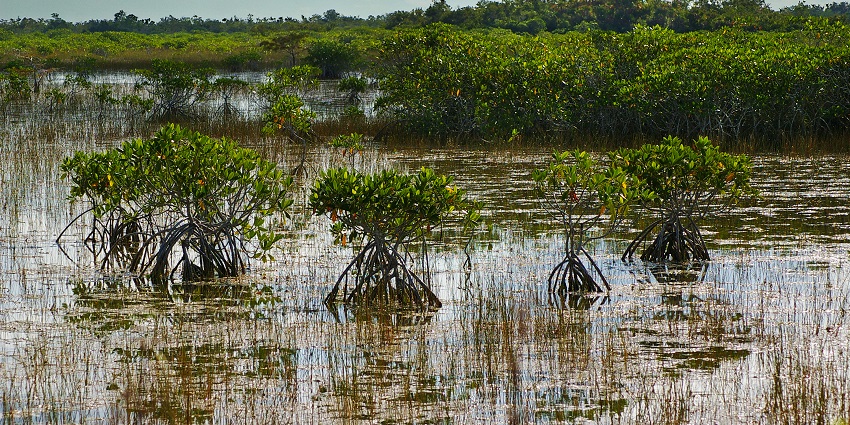
Photo: Niagara66 / Wikimedia Commons
From November through April, the Everglades see clear skies, little humidity, and warm temperatures. The average temperature is 53°F at lows and 77°F at highs. Strong cold fronts can occasionally bring temperatures close to freezing, but they are uncommon in this subtropical region.
Other Factors To Consider
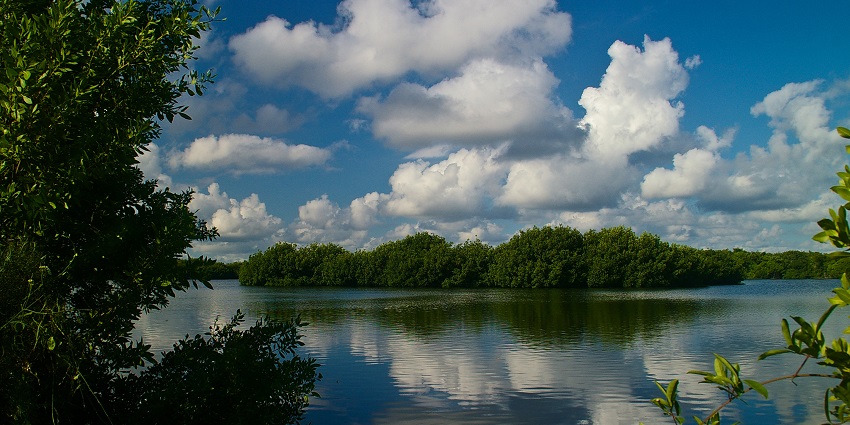
Photo: Niagara66 / Wikimedia Commons
Average Cost Of The Trip
A typical day trip to Everglades Park, including entrance fees, airboat tours, meals, and transportation, costs between $80 and $130 (₹6,500–₹10,500) per person. For a two-day stay with accommodation near the park, expenses may range from $200 to $300 ₹16,500–₹25,000. Budget-conscious visitors can save money by opting for self-guided tours, bringing packed meals, and using public transportation where available.
Tips For Travellers
- Wear light, breathable clothing and sturdy footwear for walking trails.
- Apply insect repellent to protect against mosquitoes.
- Carry sufficient water to stay hydrated in the humid climate.
- Visit early in the morning for cooler weather and better wildlife sightings.
- Book airboat and guided tours in advance to secure the best deals.
Everglades National Park is an enormous subtropical wilderness entertaining the world with an immense wealth of biodiversity and landscapes. Rich in culture and adventure-filled trails, it ensures an enriching experience for visitors. The best season, entry points, and all transportation requirements must be considered while planning a trip to make the most of this incredible destination. As you plan your stay, consider using TripXL for smooth travel bookings and expert advice to make the most of your trip.
Cover Photo: Daniel Kraft / Wikimedia Commons


 WhatsApp
WhatsApp
 Twitter
Twitter









